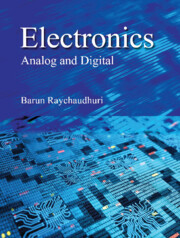Book contents
Summary
This chapter presents the concept of feedback, which means looping back a portion of the output voltage or current of an amplifier to control the system within itself. Different types of feedback and the advantages of negative feedback are clarified. The relationship between positive feedback and oscillation is explained. Two different categories of oscillator circuits are elucidated, namely the oscillators based on positive feedback and resonant circuit, such as Hartley oscillator, Colpitts oscillator, Wien bridge oscillator, phase-shift oscillator and crystal oscillator, and the switching oscillators, popularly known as multivibrators.
Concept of Feedback
Incorporating feedback to an amplifier changes its gain and other properties. During the feedback process, a portion of either the output voltage or the output current is sampled and returned to the input either in series or in parallel with the original signal. The working principle of feedback implemented to an amplifier can be interpreted with the block diagram of Figure 10.1. It comprises the following elements.
Signal Source: It may be either a voltage source or a current source. The symbol Xs denotes the signal, either the voltage or the current obtained from it.
Mixing Unit: It combines the source signal (Xs) and the feedback signal (Xf) to produce the input signal (Xi) for the amplifier.
Amplifier: It performs the basic job of amplification of a signal. It may be any one of the BJT (Chapters 5 through 8) or the FET (Chapter 9) or any circuit made of those. It may also be an operational amplifier (Chapter 11) circuit. Whatever it may be, the amplifier has a transfer gain (A) and it amplifies the input signal to produce the output of Xo. The transfer gain of the basic amplifier is given by
Sampling Unit: It picks up a fraction of the output signal (Xo) and delivers to the feedback element. The mixing and sampling units are actually series and/or parallel connections of passive elements.
Feedback Element: It is a two-port network, generally made of passive elements, supplying the sampled fraction (Xf/Xo) of the output to the mixing unit. The fraction
is called the reverse transmission factor of the feedback element and is popularly termed as the feedback ratio.
- Type
- Chapter
- Information
- Electronics , pp. 313 - 361Publisher: Cambridge University PressPrint publication year: 2023



